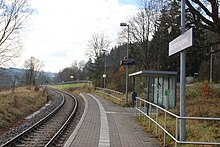Munich (Bad Berka)
|
Munich
City of Bad Berka
Coordinates: 50 ° 52 ′ 14 ″ N , 11 ° 15 ′ 15 ″ E
|
|
|---|---|
| Height : | 286 m above sea level NN |
| Residents : | 97 (December 31, 2005) |
| Incorporation : | 1836 |
| Postal code : | 99438 |
| Area code : | 036458 |
|
Location of Munich in Bad Berka
|
|
|
Munich (Bad Berka)
|
|
Munich is a district of the city of Bad Berka in the Weimarer Land district in Thuringia with 97 inhabitants.
geography
Munich is located west of Bad Berka on the northern side of the federal highway 87 in a small side valley up the Ilm towards Tonndorf . The slopes and hills that follow are forested on both sides. The Ilm flows at the foot of the southern slopes towards Bad Berka.
history
The district of Munich was first mentioned in 1115 as ad monachos (to the monks). The aforementioned monk cell originally belonged to the Peterskloster in Erfurt and later passed to the Berka monastery . In the 13th century Munich was described as desolate . The estate, which was built there later, came into sovereign possession in 1608. It was mentioned in 1823 as a village of Munich with a hereditary estate, 18 residents and four houses. In 1836 Munich was incorporated into Bad Berka. On October 10, 1898, the Sophienheilstätte for men with lung disease opened on the Emskopf above Munich , until 1994 a department of the Bad Berka Central Clinic. The former manor buildings have now been renovated.
Hunting lodge
The hunting lodge of the ducal house of Weimar stood in the surrounding area. Duke Ernst August I became co-regent of his uncle Wilhelm Ernst (Sachsen-Weimar) . He became interested in Munich because of the hunting seat of the Weimar dukes. Since 1709 he stayed regularly in the hunting lodge and began building bird houses and had an avenue laid out. The Green Palace was also built. Pleasure houses were built in the tree garden . In 1716/17 a canal was laid from the Ilm to the pleasure garden. In 1720 the pheasant house was built in the new garden. The garden was completed in 1723. Immediately afterwards his interest shifted to the Belvedere pleasure palace , where the pheasantry was moved in 1724 . After his death in 1748, the facilities were quickly run down, so it was decided to demolish. The Kammergut survived the time and shows itself (2012) as Rittergut München in a well restored condition, with an inn, farm shop, guest house and petting zoo.
Sophienheilstätte
In 1898, with the support of the Grand Ducal Family in Weimar, the then exemplary Sophienheilstätte for consumption addicts was built above the Ilm Valley . It was modernized in the 1930s under its chief physician Adolf Tegtmeier . In 1945 he was able to avert the planned conversion into a Soviet disease hospital. After the construction of the central clinic on the Hardt, the Sophienklinik served as its department for urology and orthopedics. Since 1994 the architecturally valuable building has apparently been left to decay. In January 2015 it was taken over by a local investor. The new usage concept provides for extensive renovation and expansion measures to convert the building into a home for age-appropriate living. In December 2015, no activity was discernible, rather the picture is progressive decline. One of the last two former lounge halls burned down.
District
On December 21, 2018, Munich became the eighth district of Bad Berka. With the local elections on May 26, 2019, Munich received a district council and a district mayor.
Munich has a train stop on the Ilm Valley Railway and is served every hour by the EB 26 line of the Erfurt Railway . The closest stop in the direction of Kranichfeld is Tannroda . In the direction of Weimar , the next station on the route is Bad Berka .
Web links
Individual evidence
- ^ Wolfgang Kahl : First mention of Thuringian towns and villages. A manual. 5th, improved and considerably enlarged edition. Rockstuhl, Bad Langensalza 2010, ISBN 978-3-86777-202-0 , p. 187.
- ↑ Heiko Laß: Hunting and pleasure castles. Art and culture of two sovereign building tasks. Shown on Thuringian buildings from the 17th and 18th centuries. = Hunting and pleasure palaces of the 17th and 18th centuries in Thuringia. Michael Imhof, Petersberg 2006, ISBN 3-86568-092-5 , pp. 898, 347-348, (also: Aachen, Technische Hochschule, dissertation, 2004).




